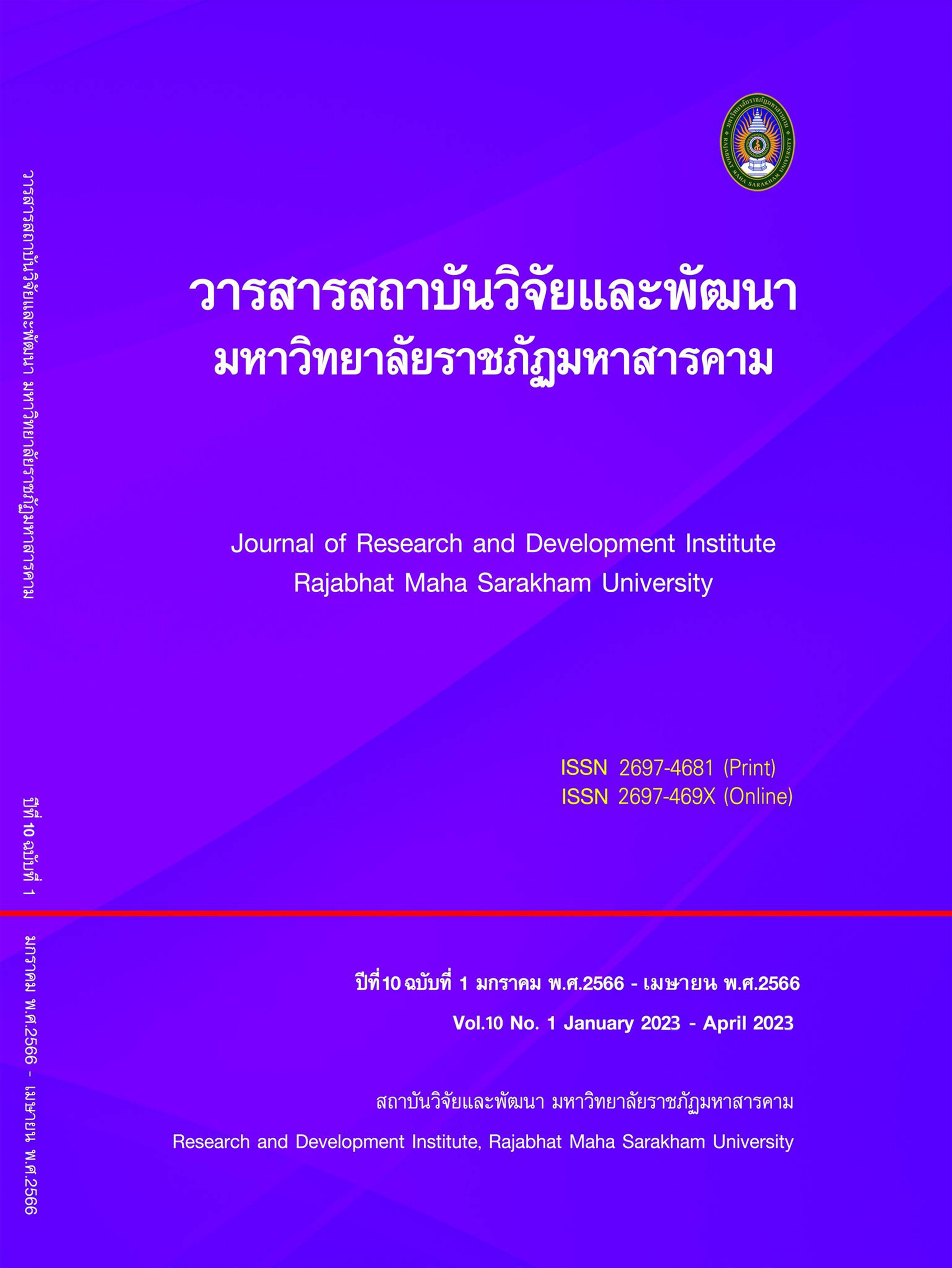Causative Factors Affecting Buddhist Tourism of Temples in Phra Nakhon Si Ayutthaya Province
Keywords:
Causal Model Analysis, Buddhist Tourism, Tourism Value Promotion, Phra Nakhon Si Ayutthaya ProvinceAbstract
This research aims to: (1) To study the importance of Buddhist tourism marketing strategies, Buddhist tourism marketing activities and Buddhist tourism components of temples in Ayutthaya province. (2)Analyze the causal relationship between tourism marketing strategies, tourism marketing activities that affect tourism components and lead to the promotion of Buddhist tourism values of temples in Ayutthaya province. And (3) Create a marketing promotion model for Buddhist tourism of temples in Phra Nakhon Si Ayutthaya Province. This research is a combination of quantitative research and qualitative research. The quantitative research was done using a questionnaire data collection method of 405 Thai tourists who traveled to temples in Phra Nakhon Si Ayutthaya Province, 9 temples, totaling 405 people. Sampling with a quota random sampling method. The qualitative research used in-depth interviews with a semi-structured interview form from 28 key informants. The statistics used to analyze the data are percentage, mean, and standard deviation. Data analysis to test the research hypothesis was based on structural equation analysis by AMOS program.
The results showed that: (1) Tourists pay high attention to Buddhist tourism marketing strategies, Buddhist tourism marketing activities, and Buddhist tourism components of temples in Ayutthaya province at a high level. (2) The results of the causal model analysis revealed that the model according to the research conceptual framework was harmonious with the empirical data with the following conformance index values: c2=137.09, df=113, c2 / df = 1.21, p-value = 0.06, ค่า GFI = 0.98, AGFI = 0.95, CFI = 1.00, NFI = 1.00, and TLI = 1.00, SRMR = 0.020, RMSEA = 0.020. The causal variable that had the most direct influence on the promotion of Buddhist tourism values was tourism activities, followed by tourism marketing strategies, and Buddhist tourism components respectively. The three variables could explain the variance in the value promotion of Buddhist tourism (R2) as 0.80(80.0%). (3) The results of this research present a model of marketing promotion of Buddhist tourism of temples in Phra Nakhon Si Ayutthaya Province.
References
Angkura, R. (2001). Research report on the readiness of temples in Bangkok regarding the propagation of Buddhism through cultural tours. Nonthaburi : Sukhothai Thammathirat Open University.
Boomsma, A. (1985). Nonconvergence, Improper Solutions, and Starting Values in LISREL Maximum Likelihood Estimation. Psychometrika, 50, 229-242.
Butthipsakul, T. (2015). Buddhist Tourism Behavior of Temple Tourists in Nan Province. Bangkok : Chulalongkorn University.
Chatchawanchanchanakit, P. et al. (2021). The influence of tourism components on the image of medical tourism in Thailand. Journal of Interdisciplinary Research: Graduate Studies, 10(2) : 1-8.
Dungsrikaew, K. (1999). The development of temples as tourist attractions. TAT Review Magazine, 18 (4), October-December.
Harueansong, P. (2018). Satisfaction of Thai tourists traveling to pay homage to 9 temples in Phra Nakhon Si Ayutthaya Province. Bangkok : Bangkok University.
Ketsomboon, N. (2012). Guidelines for the development of tourist attraction management to pay homage to the nine temples in Phra Nakhon Si Ayutthaya Province. Journal of MCU Social Science Review, 1(2) May-August 2012, 70-78.
Krueasirikun, K. (2013). Guidelines for the management and development of temple-type tourist attractions that have been successful. Flooding in Phra Nakhon Si Ayutthaya District, the historic city. Khon Kaen : Khon Kaen University.
Leo, C., Bennett, R. & Cierpicki, S., (2005). A Comparison of Australian and Singaporean Donsumer Decision-Making Styles. Journal of Customer Behavior , 4(1), pp.17-45
Naipinit, A. (2013). Study of the Religious Tourism Potential of Temples in Roi Kaen Sarasin Province Group. Panyapiwat Journal, 5(1), (July-December 2013): 31-40.
Nomnamsap, W. (2018). Strategic Plan for Sustainable Buddhist Tourism Development in Nakhon Pathom Province. Phayao : University of Phayao.
Noppakhun, P. (2019). Tourism Marketing Factors (7Ps) Affecting Foreign Divers' Decision to Travel to Scuba Diving in Thailand. Bangkok : Bangkok University.
Pelham, A. M. (2000). Market orientation and other potential influences on performance of small and medium-sized manufacturing firms. Journal of Small Business Management, 38(1), 48–57.
Phramahasuriya Masantia. (2015). Strategies for increasing marketing value for Buddhist tourism of royal temples in Rattanakosin Island. Bangkok: Siam University.
PhraMahasuthit Apakaro. (2011) Model and learning network of temple tourist attractions in Thailand. Phra Nakhon Si Ayutthay : Mahachulalongkornrajavidyalaya University.
Pitchphandecha, P. (2018). Hong Kong Island Religious Tourism Management Influencing Thai Tourists. Bangkok : Thammasat University.
Rangsikul, M. & Ratchakulpat, T. (2018). Building Competitive Advantage of Tourism Business among the Elderly in Thailand. Report from the conference. (Proceedings) The 13th Graduate Research Research Presentation Conference, Academic Year 2018, Rangsit University, Thursday 16 August 2018, 182-191.
Sangthiamchan, P. (2019). Guidelines for developing the potential of temples to become Buddhist tourist attractions. and Pilgrimage Routes: A Case Study of Temples in Maha Sarakham Province. Mahasarakham : Mahasarakham University.
Sin LYM, Tse ACA, Yau OHM, Lee JSY, Chow R, Lau LBY. (2000). Market orientation and business performance: an empirical study in Mainland China. J Global Mark 2000;14(3):5 – 29.
Subramanian, R., Gopalakrishna, P.(2001) “The market orientation–performance relationship in the context of a developing economy: an empirical analysis” Journal of Business Research,53.pp.1–13.
White, L. P. Chang, T. J. Jone, K. Y., & Hu, G. G. (2008) The Effects Of New Product Development Teams On New Product Quality: A TaiwaneseAmerican Comparison. International Journal of Organization Theory and Behavior, Vol. 11, p. 12.
Worapol, S. (2003). Temples: artistic attractions. TAT Review Magazine. 22 (3): 46-63.
.
Downloads
Published
How to Cite
Issue
Section
License
Copyright (c) 2023 นพดล กันทะวงศ์ , ศิรชญาน์ การะเวก

This work is licensed under a Creative Commons Attribution-NonCommercial-NoDerivatives 4.0 International License.
Articles that are published are copyrighted by the authors of the articles







